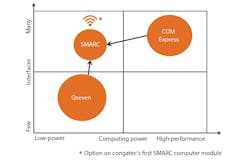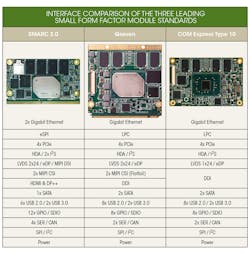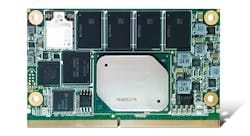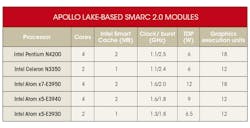Download this article in PDF format.
With the revision of 1.1 to 2.0, SMARC has evolved to a new standard with a clear profile and unique positioning for Internet of Things (IoT)-enabled multimedia platforms as well as many other graphics-intensive low-power applications. With its numerous graphics, camera, sound, network, and optional wireless interfaces, the new SMARC 2.0 specification positions itself exactly between the two well-established module standards Qseven and COM Express.
SMARC 2.0 fits between COM Express and Qseven in the competitive landscape.
Compared to the Qseven standard, which enables low-cost entry into the world of computer modules and integrates various x86 and ARM low-power processors for the process and field levels, SMARC offers more interfaces—particularly more multimedia interfaces. Compared to the high-performance COM Express modules that make up the COM performance class, SMARC 2.0 is positioned in the low-power processor segment and supports less interfaces than COM Express.
SMARC 2.0 provides a rich array of modern serial I/Os as well as video and network interfaces, suiting it well for many multimedia and graphics-rich IoT applications. To help simplify application development, congatec has come up with optional Wi-Fi and Bluetooth in compliance with the M.2 1216 interface specification to round off the interface portfolio of SMARC 2.0 modules for IoT designs. Applications can be found in digital signage systems, commercial streaming clients, industrial thin clients and HMIs, all kinds of GUI devices, point-of-sale (POS) systems, professional gaming machines, infotainment platforms, as well as IoT gateways.
Technical Highlights of SMARC 2.0
With 314 pins, the SMARC 2.0 connector—which is also used in the MXM 3.0 graphics card standard—can support up to four video outputs, thereby affording SMARC 2.0 a strong multimedia orientation. In addition, 2x 24-bit LVDS/eDP/MIPI DSI plus HDMI/DP++ and DP++, as well as 2x MIPI camera interfaces and two audio interfaces over HDA and I2S, are provided. New features include additional USB ports for up to 6x USB, including 2x USB 3.0, a second Ethernet port for segmented IoT connection or line and ring structures, a fourth PCI Express Lane. and 1x eSPI.
Discontinued is the support for the obsolete parallel camera and display interfaces, external eMMC, SPDIF, one of the three I2S channels, and the Alternate Function Block (AFB). The latter was perceived as too open by many vendors and customers, since it allowed manufacturers to implement whatever they wanted and no standardization efforts were made prior to the SMARC 2.0 specification. This is also why SMARC 1.1 modules offer very little design security if the module interfaces are executed on these pins.
Wide Array of Video-Interface Options
SMARC 2.0 offers a large selection of internal and external graphics interfaces. For the connection of external screens, there are two dual-mode DisplayPorts (also called DisplayPort++ or DP++). The advantage here is that systems supporting DP++ functionality for external displays can be controlled via DisplayPort, HDMI, and even VGA signals.
SMARC 2.0 is also very flexible and forward-looking with regard to the control of internal displays. The interface most commonly used today is LVDS. However, thanks to the two 24-bit data channels, it’s also possible to control panels with very high resolutions. In addition to the display signals, a complete set of support signals is available. As an alternative to LVDS, SMARC 2.0 modules also provide two independent embedded DisplayPort (eDP) signal sets to control two internal panels.
A third, forward-looking alternative is the option to control panels via MIPI DSI (Display Serial Interface) as specified by the Mobile Industry Processor Interface Alliance. Displays that support MIPI DSI are mostly used in smartphones. While generally smaller, these displays still feature high resolutions and are produced in very large quantities. Like eDP, MIPI DSI consists of fast serial differential wire pairs, but uses different data rates and protocols.
Two Discrete Ethernet Interfaces
Two Gigabit Ethernet ports provide a particular advantage for IoT or Industry 4.0 applications, because no additional hardware is required to realize two separate network segments for the logic and the security functions. The two GbE ports are handy for implementing cable-saving line and even redundant ring topologies. The SMARC 2.0 connector also provides software-defined pins (SDPs) for both Ethernet ports. These configurable I/Os can be used for hardware-based implementation of the Precision Time Protocol (PTP) in accordance with IEEE 1588, thereby achieving accuracies in the nanosecond range.
Wireless Technologies
SMARC 2.0 modules are well-prepared for wireless connectivity, which today is a must in many automation applications. For this purpose, the SMARC 2.0 specification defines a dedicated area on the module for the placement of the necessary miniature RF connectors for high-frequency signals (short U.FL connectors). All SMARC 2.0 modules that require antenna connections for wireless interfaces implement these connectors in the same position to ensure consistent interchangeability.
Selected congatec modules also provide appropriate wireless options, such as WLAN and Bluetooth, on the module via the standardized M.2 1216 interface specification. This widens the choice of radio protocols and maximizes flexibility when customizing end-user applications in a single module design without any additional space and design-in requirements.
The Apollo Lake-based conga-SA5 computer-on-module from congatec provides optional on-board Wi-Fi and Bluetooth (BLE).
SMARC 2.0 with Intel Atom Processors
With this feature set SMARC 2.0 is a good fit for the new Intel Atom, Celeron, and Pentium processors (codename Apollo Lake). The new low-power processors from Intel offer significantly higher performance at lower power consumption with massively improved graphics capabilities. For instance, the Intel Pentium N4200 offers a SYSmark 2014 improvement of about 30% on Windows in contrast to the earlier Intel Pentium® N3710.
With this significantly increased processor performance over the previous generation, the latest Intel Pentium and Celeron processors give embedded and IoT platforms the computing power they need. At performance ranges similar to earlier processor generations, the battery life with the new Intel Celeron or Pentium processor is expected to last approximately 15% longer.
Data for the Intel Atom processor is expected to demonstrate a similar advantage. Improvements in memory performance are enabled by new support for LPDDR4 RAM with up to 2400 MT/s. Compared to LPDDR3 or DDR3L RAM, both performing at 1867 MT/s, this delivers an improvement of approximately 30%. The new processor’s maximum memory bandwidth also jumps from 25.6 GB/s to 38.4 GB/s—an increase of 50% compared to its predecessor.
For maximum memory design flexibility, the architecture also supports 16 GB SODIMM or 8 GB memory down. For DDR3L RAM implementations, the new processor generation now supports dual-channel error correction code (ECC), a critical requirement for safety applications that demand single failure tolerance. In contrast to the earlier processor generation, this empowers designs for critical real-time embedded applications.
New Graphics Performance
The Intel Gen 9 graphics engine, initially developed for high-performance Intel Core processors, is now built into new low-power Intel Atom, Celeron, and Pentium processors as well. Up to 18 execution units are offered instead of up to 16, including support for 4K decoding/encoding of H.264 and VP8 as well as decoding of HEVC (H.265).
Performance is estimated to be three times higher than the extended temperature range options supporting Intel Atom processors with codename Bay Trail. Compared to low-power processors with codename Braswell, performance is approximately 45% higher according to the 3DMark Skydiver Graphics Score benchmark of Intel Pentium Processor N4200 versus Intel Pentium Processor N3710.
Also, 4K support is now standard even for low-power segments. The Intel Atom, Celeron, and Pentium processors support up to three 4K displays with resolutions up to 4096 × 2160 at 60 Hz. Earlier processor generations offered a mix of support with lower resolutions and only 1x 4K support at 30 Hz. Copy protection of videos is improved because the new processor generation supports HDCP 2.2 decryption and encryption of multiple streams.
Camera Image Processing
Camera-image-processing capabilities have significantly improved with the latest Intel Atom, Celeron and Pentium processor technology. Still-capture capacity is now 13 Mpixels at 30 frames/s, versus the previous 2.5 frames/s. Video-capture capabilities perform at 4K2K at 30 frames/s, in contrast to 1080 at 60 frames/s in earlier processors. HDR video can now be captured at up to 1080p at 30 frames/s, which represents a notable improvement from earlier generations that didn’t support this feature.
Up to four MIPI cameras are supported, rather than the three previously available. Processing performance of up to 165 GFLOPS and four vector units (instead of two) improve image-processing capabilities to a performance level even more suitable for smart-camera technologies.
OS Support
The Intel Atom, Celeron and Pentium processors support Windows 10 as well as Linux (including Yocto), VxWorks, and Android (Marshmallow), but consider Windows 7 and 8 obsolete. Certain applications may need adaptation toward the new Windows OS; however, this is an important step in capitalizing on the new OS benefits.
For example, Windows 10 IoT offers a range of security technologies, such as Secure Boot, BitLocker, Device Guard, and Credential Guard, to ensure that appliances are comprehensively protected from power-on to power-off. Windows 10 IoT provides flexible and necessary functions for any specific device environment, whether it’s just a single app that must be launched or access is to be restricted to non-authorized USB peripherals.
In addition, Windows activation, which is otherwise obligatory, can now be switched off to enable booting in locked network environments.
Customers further benefit from integrated interoperability, adding value to IoT-typical heterogeneous device environments. Next to embedded appliances, these also include smartphones, PCs, and laptops, as well as edge, fog and cloud servers. Development of universal apps is less complex, along with a simplified approach to enabling the security and management of IoT applications. Developers can reduce resources for these efforts and focus exclusively on their core competencies.
Real-Time Feature Adds
The new Intel processors also include Precision Time Management support; the processor synchronizes its CPU with I/Os to improve determinism for directed I/Os. This technology offers a Core Time Stamp Counter as well as PCIe clock synchronization, enabling the processor to prevent cache collisions. Virtual Channel (Intel VT) functionality is now supported to the CPU edge and includes a Memory Arbiter QOS between the CPU and Virtual Channel.
Back Again: The Extended Temperature SKUs
Because Intel opted to drop its extended temperature support for the previous generation of Intel Atom processors (codename Braswell), engineers needed to wait for the evolution from Bay Trail to Apollo Lake for this functionality. SMARC 2.0 modules with these new Intel Atom processors are able to withstand harsh environments ranging from −40°C up to +85°C ambient temperature, establishing this new module generation as a multi-purpose option for designs in various application areas. The variants with Intel Celeron and Intel Pentium processors are designed for 0°C to +60°C. In line with embedded market demands, modules with these processor families also offer long-term availability of seven years.
SMARC 2.0 with USB C Support
With SMARC 2.0, developers can now take advantage of the latest USB-C implementations. Utilizing the USB-C specification makes USB interconnects even more universally applicable, further standardizing the interface setup of SMARC 2.0-based embedded devices.
System designers can use USB-C for standard peripherals from USB 3.1 to USB 1.0 and—a brand new option—for connecting displays or even the power supply to the system or peripheral devices, reducing cabling efforts to a single cable. In addition, the current data throughput of up to 5 Gb/s in line with the USB 3.1 specification serves as a turbo charger for data-intensive applications.
Employing this universally applicable form of plug-and-play functionality greatly simplifies the use of embedded technology. Fully featured USB-C jacks are still rare and present a real breakthrough for standardizing the fragmented world of cable-based external interconnects.
Such standardization is very beneficial for system engineers as well as system integrators, administrators, and device users. System engineers don’t need to think about the interface setup anymore. They only need to specify the number of USB-C compliant peripherals they want to interconnect and design in USB-C interfaces accordingly. And system integrators can plug their USB-C compliant peripherals in any USB jack available on the board and it works.
We know that we’re only at the beginning of this evolution and that 100% availability of fully featured USB‑C jacks is still a vision today. But, imagine how easy system specifications will become once this transition is complete.
A design example of a USB-C implementation for SMARC is the new evaluation carrier board “conga-SEVAL.” The comprehensive USB-C functionalities include USB 2.0, USB 3.1 Gen 1 support with data rates of up to 5 Gb/s, and the alternate modes for DisplayPort 1.2 (DP-Alt) and USB Power Delivery (USB-PD) supporting a power envelope of up to 100 W. All signals are simultaneously present at the point-symmetric female USB-C connector with 24 signal pins. For the power modes, the solution supports all USB-PD modes as specified by the Universal Serial Bus Implementers Forum (USB-IF).
Besides the USB 3.0-compliant mode with 5 V and 1.5 A, it can provide additional voltages of 12 V and 15 V with a maximum current of 3 A, and also 20 V with 5 A maximum current. Thanks to this, USB-C also becomes a unifying power-supply standard for both peripheral devices and systems. OEMs and developers can use congatec’s new SMARC module and carrier board as an application-ready design-in solution for off-the-shelf evaluation of this new technology.
OEMs with SMARC 1.1 devices can request a free upgrade check from congatec.
IoT Support
The only thing still missing for the latest applications is advanced IoT support, as the Standardization Group for Embedded Technologies (SGET) hasn’t yet released a vendor-independent cloud application-programming-interface (API) specification. As a result, companies like congatec have come up with solutions to simplify orchestration of wireless sensor networks.
For instance, the firm’s “Cloud API for IoT Gateways” is capable of integrating any local sensor networks into any cloud solution. It communicates with local smart sensors, processes and converts the acquired data, and executes automated actions based on a local rule engine, reducing traffic to the IoT cloud and enabling fast local actions. Secure bidirectional data exchange with any suitable clouds is achieved by using the TLS secured MQTT protocol. The design solution utilizes the Microsoft Azure cloud. Clients can access this cloud via https in client or administrator mode.
With these features, the Cloud API for IoT Gateways can become a starting point for OEMs that need to access smart sensor networks via IoT gateways and IoT edge servers. Typical application areas can be found in various IoT segments, from industrial production and machinery to smart cities, smart facilities, smart homes, smart energy grids, medical IoT, the transportation sector, and digital signage. The Cloud API’s freely programmable software modules can be instantly utilized to get access to congatec boards and their data, as well as connected sensor networks. They’re available in C++.







